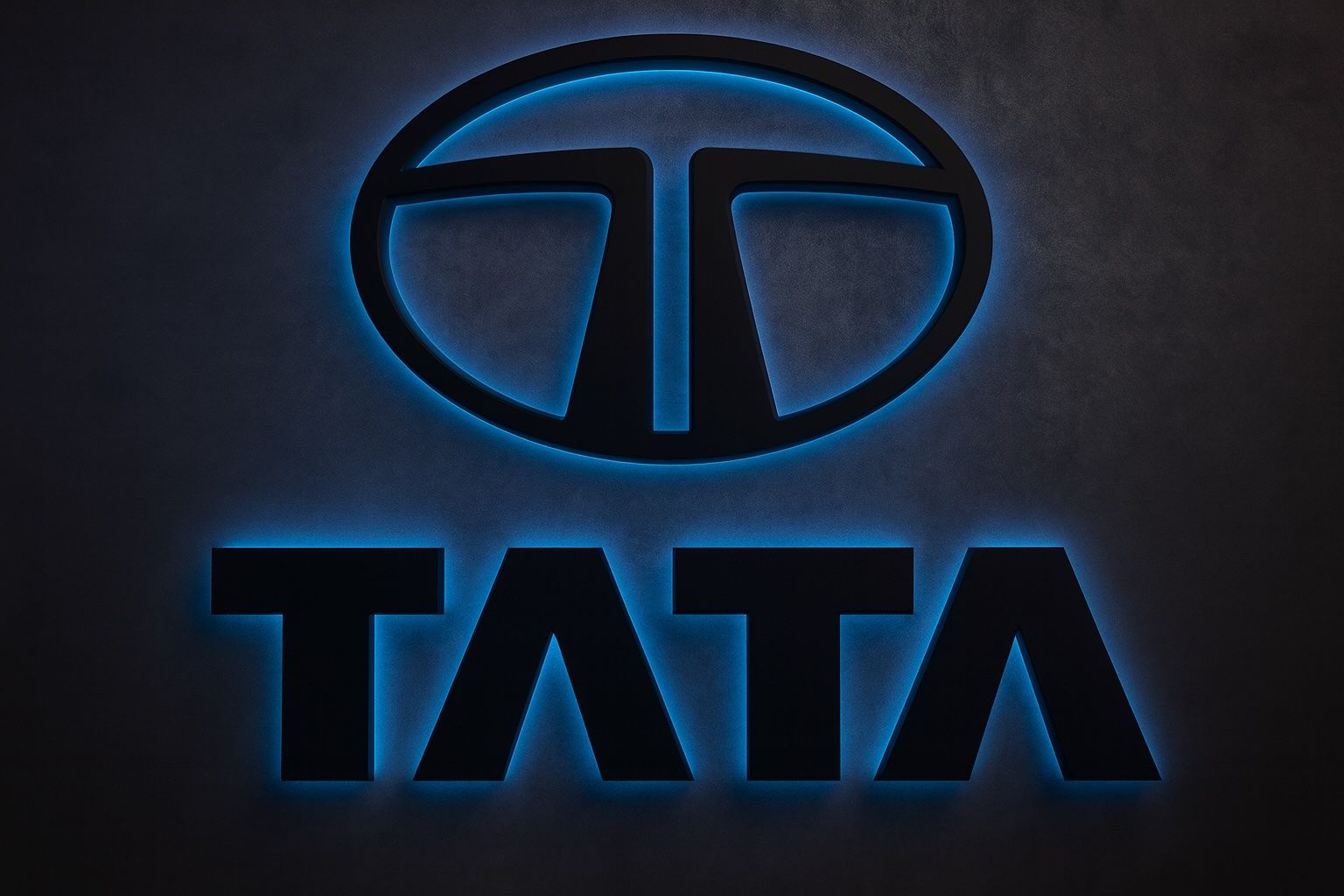- Mega IPO Opens: Tata Capital’s much-anticipated IPO opened on October 6, 2025 and closes on October 8, aiming to raise ₹15,512 crore (₹155.12 billion) [1]. This is India’s largest IPO of 2025, even bigger than Hyundai India’s 2024 listing [2] [3]. Shares are priced in a band of ₹310–₹326, with a lot size of 46 shares (minimum ~₹14,260 investment) [4] [5]. Trading is expected to start on October 13 [6].
- Issue Structure: The offering comprises 47.58 crore shares, including a fresh issue of 21 crore new shares and an Offer for Sale (OFS) of 26.58 crore shares [7]. Promoter Tata Sons is selling 23 crore shares and stakeholder IFC (World Bank’s arm) is offloading 3.58 crore shares [8]. Proceeds from the fresh issue (~₹6,846 crore) will go to Tata Capital to boost its Tier-1 capital for future lending growth, while OFS proceeds (~₹8,666 crore) go to the selling shareholders [9] [10].
- Strong Anchor Backing: Ahead of the IPO, Tata Capital raised ₹46.4 billion from 135 anchor investors, including marquee global funds Morgan Stanley, Goldman Sachs, Nomura, and India’s largest insurer LIC [11]. This robust institutional interest signals confidence in Tata Capital’s long-term prospects [12].
- Flagship NBFC & Growth: Tata Capital is the flagship financial services arm of the Tata Group. It’s India’s third-largest diversified NBFC with gross loans of ₹2.33 trillion as of June 2025 [13]. The loan book grew at a blistering 37.3% CAGR (FY23–FY25) [14]. The company has served 7.3 million+ customers since 2007, focusing ~88% of its portfolio on retail and SME loans [15]. Asset quality is healthy with gross NPAs (Stage 3) at only 2.1% and Provision Coverage Ratio ~54% [16] – among the best in the sector.
- Financials: Tata Capital’s FY25 profit after tax jumped to ₹3,655 crore (up from ₹3,327 cr in FY24) on revenue of ₹28,313 crore (vs ₹18,175 cr a year earlier) [17]. Total assets reached ₹2.52 lakh crore by June 2025 [18]. However, profitability ratios lag top peers – Net Interest Margin ~5%, Return on Assets ~1.8% and RoE ~12-13%, versus much higher returns (RoA 4-5%, RoE ~19%) at leaders like Bajaj Finance [19] [20].
- Valuation & Market Cap: At the ₹326 upper band, Tata Capital commands a post-issue market cap ~₹1.38–1.40 lakh crore (~$15.7 billion) [21] [22]. That’s valued at ~3.4x post-book (4.1x trailing book) and a P/E of ~32× FY25 earnings, which is in line with large NBFC peers [23] [24]. In fact, the IPO values Tata Capital at over twice the market cap of HDB Financial Services, another major Indian NBFC that listed earlier in 2025 [25]. SBI Securities notes Tata’s valuation is at the upper end of “fair” range, though still cheaper on book value than premium peers like Bajaj Finance or Cholamandalam [26].
- Subscription Response: Investor response has been strong but measured. Within the first hour of Day 1, the issue was 15% subscribed [27]. By early afternoon, overall subscription reached about 24–28% of the issue size [28], led by Qualified Institutional Buyers (QIBs) bidding for ~29% of their portion, with retail investors ~24% and non-institutional (HNI) ~16% so far [29]. The employee reserved quota saw even higher take-up (~75% by midday) [30]. This steady demand suggests interest across categories, with institutions showing the highest early appetite.
- Grey Market Premium:Grey market signals have been modest. Before the IPO, the grey market premium (GMP) was only around ₹7–₹10 (roughly 3% above issue price) [31]. Some trackers later showed GMP rising to ₹20–₹24 (~6–7% upside) as the issue opened [32]. This indicates expectations of a mild listing gain, not a huge pop. Analysts caution that much optimism is already priced in, so short-term gains could be limited [33].
- Expert Verdict – Subscribe or Skip?Most brokerages advise “Subscribe – Long Term.” Anand Rathi gave a Subscribe rating, citing Tata Capital’s strong loan growth, stable margins, and prudent risk management, and noted the issue is attractively priced vs peers [34]. Prashanth Tapse of Mehta Equities agrees the pricing leaves “decent headroom for a healthy listing pop,” as Tata’s management sensibly priced it slightly below industry averages [35]. Several experts highlight Tata Capital’s flagship status, Tata-brand trust, and diversified portfolio as merits for long-term investors [36]. However, they also acknowledge near-term returns are muted by the company’s thinner margins. As ICICI Direct puts it, Tata Capital is “well-capitalised, diversified and prudently managed…with strong parentage,” even if profitability is lower than top rivals [37]. The consensus: invest for stability and steady growth rather than quick gains [38].
Tata Capital IPO Overview & What’s at Stake
Tata Capital Ltd – the financial services flagship of the 155-year-old Tata Group – is making its stock market debut with one of India’s biggest IPOs ever. The ₹15,512 crore (~$1.7 billion) offering opened for public bidding on October 6 and runs till October 8 [39]. This IPO is the largest in India this year, surpassing all other 2025 listings and even putting the Indian IPO market on track for a record fundraising month [40] [41].
The shares are offered in a price band of ₹310 to ₹326. Retail investors must buy at least one lot of 46 shares, meaning a minimum outlay of about ₹14,260–₹14,996 at the upper price [42]. The stock is set to list on both the NSE and BSE exchanges, with trading expected to commence on October 13, 2025 [43]. Allotment of shares to applicants is likely by October 9, given the tight IPO timeline [44].
This IPO is crucial for Tata Capital’s growth plans. The company will issue 21 crore new shares, roughly ₹6,846 crore in fresh capital, to bolster its equity base [45]. Tata Capital’s Tier-1 capital ratio is expected to jump from ~12.8% to over 22% post-IPO [46], significantly strengthening its balance sheet. Management says this capital infusion, along with internal accruals, can fund the company’s expansion for the next 2–3 years without needing acquisitions [47]. In essence, the IPO proceeds will fuel more lending across retail, SME, and corporate segments, allowing Tata Capital to capture rising credit demand in India.
The rest of the shares – 26.58 crore – are being sold via an Offer for Sale, mainly by Tata Capital’s promoters. Tata Sons, the holding company of the Tata empire, is paring its stake by selling 23 crore shares, while International Finance Corporation (IFC) (a World Bank group investor) is selling 3.58 crore shares [48]. Prior to the IPO, Tata Sons held a dominant stake (over ~88% in Tata Capital) and IFC around 2% [49] [50]. Post-listing, Tata Sons will remain the majority owner but with its stake diluted by roughly 11% [51]. The OFS portion (worth ~₹8,666 crore) allows these existing shareholders to monetize part of their holdings; those proceeds won’t go to the company but to the sellers [52].
For Tata Group, this marks the second major IPO in recent times – following the blockbuster Tata Technologies IPO in late 2023 [53]. Tata Tech’s listing was a huge success, debuting at a sharp premium and demonstrating investor appetite for Tata offerings. Naturally, all eyes are on Tata Capital to see if it can replicate that success [54]. The Tata brand name carries weight in the market, and Tata Capital’s IPO is seen as a barometer of both the group’s financial arm strength and the overall market sentiment for large issues.
Inside Tata Capital: Flagship NBFC with Rapid Growth
Tata Capital is a diversified non-banking financial company (NBFC) that serves as the Tata conglomerate’s flagship in financial services. Established in 2007, the company has grown into one of India’s largest NBFCs, offering a broad suite of financial products – from home and vehicle loans to business loans, consumer finance, wealth management, and more.
Scale & Market Position: As of mid-2025, Tata Capital manages ₹2.33 trillion in loans (AUM) [55], making it the third-largest NBFC in India after giants like Bajaj Finance and Shriram Finance [56]. It operates an extensive “phygital” distribution network of 1,516 branches across India supplemented by digital platforms and over 30,000 partner outlets [57] [58]. This omni-channel reach allows Tata Capital to tap customers in metros as well as deeper geographies [59]. Since inception, Tata Capital has served over 7.3 million customers and built a diversified loan portfolio with a significant retail focus [60].
Loan Book & Segments: Nearly 88% of Tata Capital’s loan book is retail and SME loans [61], which include personal loans, home loans, vehicle and equipment finance, microfinance, etc. The remaining portion covers corporate and infrastructure financing. This retail-heavy mix means Tata Capital benefits from broad-based consumer credit growth, while keeping large single-borrower exposures low. In fact, over 98% of its accounts are small-ticket loans, which reduces concentration risk [62]. About 80% of the loans are secured against collateral, lowering credit risk further [63].
The company has expanded its lending rapidly. Between FY2023 and FY2025, Tata Capital’s loan book grew at ~37% CAGR, one of the fastest among large lenders [64]. Even accounting for the merger of Tata Motors Finance Ltd (TMFL) – which was integrated into Tata Capital recently – the growth has been robust. This merger added a huge commercial vehicle financing portfolio (with a ₹10 lakh crore market opportunity) to Tata Capital, which the company is now leveraging with its credit and tech expertise [65]. The CEO, Rajiv Sabharwal, indicated they will push deeper into affordable housing loans, micro home loans, equipment finance, and leasing – higher-yield segments to boost margins [66] [67].
Asset Quality & Risk Management: Despite rapid growth, Tata Capital has kept its asset quality under tight control. Its gross Stage 3 (NPA) ratio is just 2.1% (as of June 2025) [68], which is impressively low in retail lending. The net NPA would be even lower given a provision coverage of ~54% [69]. By comparison, many peer NBFCs have gross NPAs in the 3–5% range. Tata Capital’s relatively prudent credit culture and strong underwriting are credited for this stability [70]. The company maintains credit costs below 1% of assets, and keeps unsecured loans only ~12% of the book [71] – indicating a conservative risk approach.
Moreover, Tata Capital boasts the highest domestic credit rating (AAA), and a decent international rating (BBB-, constrained by India’s sovereign rating) [72]. These ratings translate to one of the lowest cost of funds among NBFCs [73], a crucial competitive edge. In FY25, Tata Capital’s cost of funds was ~7.8%, which is on par or lower than peers [74]. The Tata pedigree and stable governance give lenders and investors comfort, enabling Tata Capital to borrow at fine rates. The company has diversified funding sources – bank lines, bonds, market borrowings – ensuring ample liquidity to support growth.
Earnings & Margins: In the past few years, Tata Capital’s profits have surged, though partly aided by scale. FY25 PAT was ₹3,655 crore, up ~10% from FY24 [75], on a revenue of ₹28,313 crore (which jumped ~56% year-on-year) [76]. The rapid loan growth has driven earnings higher. However, return ratios remain moderate: Return on Assets (RoA) is under 2% and Return on Equity (RoE) ~12-13% [77] [78]. These are decent but significantly lower than top-tier Bajaj Finance (RoA ~4.6%, RoE ~19% [79]). Tata Capital’s net interest margin (NIM) of ~5.2% [80] also trails some peers that enjoy 8-10% NIMs.
Why the lower profitability? Analysts point to higher credit costs (Tata Capital is conservative in provisioning, with coverage ~59% [81]), a recent rise in funding costs (interest rates rose industry-wide), and integration drag from TMFL merger (which temporarily dented ratios) [82]. Also, being a newer player relative to decades-old peers, Tata Capital hasn’t yet reached the operating efficiency or fee income levels of, say, Bajaj Finance. Its cost-to-income ratio and operating expenses are areas the management is focusing to optimize (through technology adoption, AI, etc.) [83]. The CEO has stated initiatives to use Gen AI and digital processes to reduce costs and improve RoA over time [84].
Overall, Tata Capital offers a balanced growth story: high growth and a resilient loan portfolio, but profitability that needs to catch up. The IPO will shore up capital and could accelerate growth into new high-margin segments, but investors will be watching if margins improve and if the company can extract more profit from its expanding balance sheet.
IPO Valuations – Fairly Priced or Tata Premium?
A key question is whether Tata Capital’s IPO is fairly valued or expensive. At the top end price of ₹326, the company will be valued around ₹1.38–1.40 lakh crore (₹1.4 trillion) [85], making it more valuable than many banks and NBFCs on the market. This market cap implies roughly 3.4x price-to-book (P/B) on the post-IPO equity and about 32x price-to-earnings (P/E) based on FY25 earnings [86] [87]. Let’s put that in perspective:
- In line with large NBFC peers: Other large, diversified NBFCs trade in a wide P/B range (2x to 6x) depending on their quality and growth [88]. For instance, Bajaj Finance – known for high growth and profitability – trades around 7x book and ~37x earnings [89], clearly at a premium. More average peers trade ~2-4x book. Tata Capital’s 3.4x is towards the higher side of mid-tier, reflecting its strong parentage and stability. SBI Securities noted the IPO valuation lies “towards the upper end of the fair range,” considering Tata Capital’s near-term profit constraints due to the TMFL merger [90]. Deven Choksey Research similarly called it “fairly valued at 4.1× P/B” given its ~1.9% RoA versus peers averaging 3% RoA [91].
- The “Tata premium”: Many analysts believe investors are willingly paying a “Tata premium” – valuing Tata Capital richly not for its current earnings, but for its long-term stability and governance. Unlike some high-growth lenders that might be riskier, Tata Capital offers the comfort of the Tata brand, conservative management, and lower credit risk. ICICI Direct highlighted Tata Capital’s “AAA rating, strong parentage, and prudent management”, implying the quality deserves a premium [92]. In other words, the market may be valuing Tata Capital more for what it represents (solidity, trust) than purely its EPS. This premium is evident when comparing profitability: Tata Capital’s RoE ~12% is much lower than peers like Cholamandalam (RoE ~18%) or Bajaj Finance (~19%), yet its P/B is not proportionately lower [93] [94]. Brokerages attribute this to investor confidence in Tata’s governance and risk discipline, rather than superior earnings [95].
- Fully Priced for Now: Several experts thus conclude the IPO is “fully priced”, leaving limited immediate upside. Macquarie reportedly cautioned about “the heights of valuation” (as per media chatter), and Moneycontrol’s Shaleen Agrawal writes that despite Tata Capital being well-placed to grow, “investors should view the issue as fully priced for stability rather than near-term alpha (quick gains)” [96]. In plainer terms, don’t expect Tata Capital to skyrocket on listing like a penny stock; it’s more of a steady compounder story. The share might list at only a modest premium (if grey market indicators hold true) and then move in line with the company’s performance.
That said, the valuation is not wildly unreasonable either. At 3.4x book, Tata Capital is actually cheaper than some marquee peers when adjusted for growth. For example, HDB Financial Services (HDFC Bank’s NBFC arm) listed earlier in 2025 and had a strong debut; Tata Capital’s pricing values it at about half HDB’s valuation multiples, even though Tata is larger in loan book [97]. Relative to Bajaj or Cholamandalam, Tata Capital’s ~32x P/E is lower than Bajaj’s ~37x and closer to Cholamandalam’s range. SBI Securities even noted that at 3.4x book, Tata Capital is “attractive compared to peers” like Bajaj, Chola, and HDB Financial, which trade at higher multiples [98]. This suggests the pricing is balanced – not a steal, but not extortionate. Investors are paying for Tata’s strong fundamentals and getting a stable NBFC at a valuation that largely mirrors the sector’s average.
Ultimately, the “Tata premium” debate boils down to whether you value governance and lower risk over raw profitability. If you do, Tata Capital’s IPO price seems justified, since the company brings a clean loan book, reputable brand, and backing of India’s most trusted conglomerate. If you’re seeking high short-term returns, the valuation might look rich because Tata Capital isn’t (yet) as profitable as the market darlings. As we’ll see, most experts are leaning toward the former view – that Tata’s franchise strength warrants a long-term bet, even if immediate returns are moderate.
Investor Response: Subscription Trends and GMP Signals
The Tata Capital IPO has generated significant buzz and a healthy response from investors, though not the frenzied, oversubscribed-on-day-one scenario seen in some smaller IPOs. Here’s the state of play:
- Day 1 Subscription: On opening day (Oct 6), the issue saw a steady flow of bids across all segments. Within the first hour, about 15% of the total issue was subscribed [99], indicating solid early interest. By mid-day, subscription climbed to roughly 24–28% of the issue size [100]. In absolute terms, by 11:30 AM about 6.5 crore shares had been bid for out of ~33 crore shares available (excluding anchors) [101]. QIBs (institutions) led the charge – their portion was nearly 29% booked by mid-day [102], reflecting confidence from domestic mutual funds, insurance firms, banks, and FPIs. Retail investors had put in bids for about 24–28% of their quota by afternoon [103], which is a decent turnout on Day 1 for a large issue. The Non-Institutional Investors (NIIs) – i.e. HNIs and corporates – were a bit slower with roughly 16–20% subscription of their portion by mid-day [104]. Interestingly, Tata Capital’s own employees (who have a small reserved quota) enthusiastically subscribed 75–90% of their shares on Day 1 [105] [106], indicating strong belief in the company from insiders. These figures suggest that institutional buyers are showing up early, which is a positive sign. QIB interest is crucial for an IPO of this size, and anchor allocation already indicated high institutional appetite. Retail response, while not a stampede, is expected to build up over the three-day window as more investors digest the IPO analysis. Many brokers had given subscribe recommendations, which usually spurs retail bidding towards the end. We’ll need to see if Day 2 and 3 push the subscription into multiple times oversubscription. Given the large issue size, even 2-3x overall subscription would be a strong outcome. (For context, HDB Financial’s IPO was ~1.1x subscribed overall in 2025 due to its huge size, yet it still listed successfully.)
- Anchor Investors: As mentioned, Tata Capital already raised ₹4,642 crore from anchors on Oct 3 (just before the IPO) [107]. A total of 135 institutional investors came in as anchors, including big global names like Morgan Stanley, Goldman Sachs, Nomura, Abu Dhabi Investment Authority etc., and nearly 20 domestic mutual funds pooling in over ₹1,650 crore [108]. Government-owned LIC emerged as the largest anchor investor in Tata Capital [109]. The anchor book being fully subscribed and diversified is a strong vote of confidence. It essentially means one-third of the IPO issue was already taken up by professional investors at the top price, even before the public bidding began. This broad institutional participation, according to analysts, “reinforces long-term confidence but also suggests listing gains may be limited” (since much of the demand was met at the IPO price itself) [110]. In other words, anchors ensure the IPO won’t flop, but they also soak up some of the buying that might have driven up prices on listing day.
- Grey Market Premium (GMP): The grey market – an unofficial market where IPO applications are traded ahead of listing – has been lukewarm on Tata Capital. Initial reports before the IPO opened indicated only a small premium of ₹7–₹10 per share in the grey market [111]. That’s roughly a 3% uplift over the issue price, implying a potential listing price around ₹336 if the issue is at ₹326 [112]. As trading began on Day 1, some grey market trackers noted the premium widened slightly to ₹20+ (around 6% above IPO price) [113], perhaps reflecting the decent QIB response. Even at ₹20 GMP, the implied listing gain is about 6-7%, meaning the stock might list around ₹345 if the sentiment holds [114]. By grey market standards, these are modest numbers – especially for a Tata offering. It suggests traders expect Tata Capital to list near its offer price, with maybe a small pop. The GMP can fluctuate until listing, but the current indication is nowhere near the 30-50% GMP pops seen in some recent mid-cap IPOs. This isn’t too surprising: large issues like this often have limited GMP because their supply is ample and the pricing is more mature. Additionally, since many analysts are calling it fully valued, short-term punters may not be as aggressive here. In fact, grey market activity also reflects that the IPO is considered reasonably priced – no huge arbitrage for a quick flip.
- Market Mood: Tata Capital’s IPO is hitting the market at an interesting time. The overall stock market had cooled off a bit in 2025 after a 9-year bull run, and there were concerns about earnings growth and global tensions [115]. Despite that, India’s IPO market stayed hot, with $11.2 billion raised in the first 9 months of 2025 [116]. Investors have plenty of liquidity (domestic mutual funds are seeing record inflows via SIPs, as one expert noted) [117]. Recent regulatory tweaks – like RBI raising the IPO financing loan limit to ₹25 lakh for individuals [118] – also boosted sentiment by making funding for big IPO applications easier. No wonder October 2025 is set to be a blockbuster month: right after Tata Capital, LG Electronics’ India unit is launching another ~$1 billion IPO the next day [119]. It appears there is “ample capacity to absorb” these large issues now, as one market observer, Raghuram K., put it, given the cash flooding into mutual funds and the hunger for quality offerings [120].
In summary, the initial demand for Tata Capital’s IPO is solid and confidence-inspiring, though not manic. The company’s strong fundamentals and Tata branding attracted big institutional money early on. Retail investors are participating steadily, and there’s no sign of any trouble in subscription. However, the tempered grey market premium is a useful reminder that this IPO isn’t a get-rich-quick scheme – it’s about steady long-term value. The market seems to be treating Tata Capital as a blue-chip debut, not a speculative bet, which actually bodes well for stability post-listing.
Expert Opinions: To Subscribe or Not?
So, should investors apply for Tata Capital’s IPO? The consensus among market experts and brokerage houses is leaning YES – especially for long-term investment. Here’s a roundup of what analysts are saying:
- Anand Rathi (Brokerage): “Subscribe (Long Term)”. Anand Rathi’s IPO note gives Tata Capital a thumbs up, highlighting its strong loan growth, stable margins, and low credit costs [121]. They believe the issue is attractively priced compared to peers and expect a “healthy market debut with solid long-term growth potential” [122]. The firm likes Tata Capital’s omni-channel reach and notes that 80% of loans being secured and 98% small-ticket is a de-risking factor [123]. While valuations are not cheap, Anand Rathi feels the Tata “credibility and governance pedigree” justify investing for the long haul [124].
- Aditya Birla Capital (Brokerage): “Subscribe – Long Term.” AB Capital’s view is similar to Anand Rathi’s (in fact, Moneycontrol reported both advising long-term subscribe) [125]. They cite Tata Capital’s group credibility, adequate capital buffers post-IPO, and scalable business model as reasons the company can deliver solid growth over time [126]. The compressed current margins are a concern, but they expect improvement as the company increases its share in higher-yield segments and leverages technology.
- Mehta Equities (Analyst Prashanth Tapse): Bullish on listing gains. Prashanth Tapse, Senior VP at Mehta, noted that Tata Capital’s management has “sensibly priced the IPO slightly below the industry average, leaving decent headroom for a healthy listing pop.” [127] He praised the decision to not overprice the issue despite high market interest, implying that the stock could see an initial jump. Tapse also pointed out that market sentiment is favorable, and Tata’s strong brand plus reasonable pricing make a recipe for at least a short-term upside on listing [128]. His take is encouraging for those looking at near-term performance – essentially saying the IPO isn’t overpriced and investors might reap a quick reward.
- SBI Securities: Cautious optimism. SBI Securities, as noted earlier, said Tata Capital’s valuation is at the upper end of fair and flagged the near-term profitability pressure from the TMF (Tata Motors Finance) merger [129]. They are optimistic about Tata Capital’s fundamental strengths – well-diversified, strong parent backing, good asset quality – but they temper expectations by calling the pricing fair rather than cheap. In their comparison, Tata Capital sits “midway” between super high-growth NBFCs and stability-focused ones [130], which is actually not a bad place to be. They haven’t explicitly said skip or subscribe (in fact, they likely are among those not giving a formal rating), but their analysis suggests long-term investors can consider it, with moderated expectations.
- ICICI Direct: Positive on fundamentals. ICICI’s retail brokerage arm did not assign a formal subscribe/avoid rating, but their commentary was positive: they describe Tata Capital as “well-capitalised, diversified and prudently managed…with strong parentage and brand equity” [131]. They also highlighted the resilient business model and sustained growth focus in their note to clients [132]. ICICI Direct appears to believe the company has a robust platform to build on, though they acknowledge the valuations are not low. They specifically pointed out that at 3.4x book, Tata Capital is still cheaper than Bajaj Finance and Cholamandalam in relative terms [133] – an implicit nod that the price is reasonable.
- Deven Choksey Research: Neutral to cautious. Choksey’s firm pointed out the dichotomy: “while Tata Capital is well placed to scale its loan book at a healthy pace, its returns appear low compared with other listed NBFCs.” [134] They emphasize that even with brand strength and a comfortable balance sheet, investors should temper expectations. In essence, Choksey is saying don’t buy Tata Capital expecting it to perform like Bajaj Finance in the short term – the latter’s high RoA/RoE justify its premium, whereas Tata Capital’s lower profitability means its stock may not outperform dramatically in near term. They seem to agree the issue is priced for stability (quality and safety) rather than for delivering quick alpha [135]. This view is more of a “subscribe only if you are a conservative, long-term investor” stance.
- Market Gurus & Media: Apart from brokerages, market commentators have noted that Tata Capital offers a unique exposure to the Tata Group’s financial arm, which hadn’t been available to stock investors till now. Many see it as a proxy to play India’s credit growth with Tata’s trademark reliability. There is also talk that Tata Capital’s listing could unlock value for Tata Sons (the promoter), and possibly pave the way for more Tata group listings (even Tata Sons itself someday, as speculation goes) [136]. On the flip side, some have quipped that Tata Capital’s lower margins mean it’s “no Bajaj Finance” – so investors must align their expectations accordingly. Notably, most analysts have refrained from an outright “Avoid” call. Even those who find the valuation rich are not negative on the company; they mostly suggest that if one is looking for short-term thrills, this IPO might not provide that, but it’s a solid bet for patient investors.
Bottom line: The broad expert view is favorable. The IPO has enough fundamental merit and fair enough pricing that subscribing makes sense, particularly as a long-term holding. The Tata brand, the company’s growth trajectory, and the robust risk management framework all make it an attractive addition to a portfolio – akin to buying into a quasi-bank with Tata’s DNA. However, expectations should be realistic. Don’t expect multi-bagger returns in a year; instead, expect a steady compounding of value. As India’s credit market expands and Tata Capital leverages its new capital to grow, shareholders could be rewarded with consistent growth in earnings and stock value. In the short term, listing gains look to be moderate – perhaps mid-single-digit percentage – so the IPO isn’t a pure listing flip candidate but rather a quality stock to own and hold.
The Bigger Picture: Why Tata Capital IPO Matters
Tata Capital’s IPO is not just another listing; it carries significance for multiple reasons:
- Largest IPO of 2025 & Market Boost: At ₹15,500+ crore, this is the biggest IPO India has seen in 2025 [137]. Such a large offering tests the market’s depth. A successful Tata Capital listing would signal that India’s capital markets can absorb big-ticket issues, reflecting strong liquidity and investor confidence. This comes at a time when, globally, IPO markets have been patchy. India bucked the trend with a robust IPO pipeline, and Tata Capital could set the tone for other big upcoming deals. Indeed, October 2025 might set a monthly record of >$5 billion in IPO proceeds if Tata Capital and other slated issues go well [138].
- Investor Appetite for Financials: Financial services companies often attract a lot of investor interest because they are a proxy for economic growth. Tata Capital, being an NBFC, falls squarely in that category. Its IPO will reveal how much appetite investors have for lenders in the current climate of slightly higher interest rates and intense competition. The early signs (anchor demand, QIB response) suggest appetite is strong for well-run financials. This bodes well not just for Tata Capital but for other finance firms (banks, NBFCs, fintechs) considering IPOs.
- Tata Group Strategy: For the Tata conglomerate, listing Tata Capital is a strategic move. It helps unlock value and raise funds without adding debt. Tata Sons, which owns the majority of Tata Capital, could use the OFS proceeds for other group investments or debt reduction. Moreover, a successful listing enhances Tata Group’s reputation in capital markets. It’s worth noting Tata Group had kept Tata Capital private for 16+ years – listing it now perhaps indicates that the business has matured and is ready to stand on its own. There’s also speculation around Tata Sons itself possibly going public in the future [139], and steps like this fuel such chatter. At the very least, Tata Capital’s IPO will add a pure-play Tata finance stock to the market, giving investors a new way to participate in the Tata story beyond the traditional manufacturing and IT companies (TCS, Tata Motors, etc.).
- Impact on NBFC Sector: When a sector leader lists, it often re-rates the sector. Tata Capital’s valuation and post-listing performance could impact how investors view other NBFC stocks. If Tata Capital commands a premium valuation due to its brand and size, smaller NBFCs might see more differentiation – quality names might get a boost while weaker ones could be viewed at a discount. Already, we saw some movement: the shares of Tata Investment Corp (which holds stakes in Tata companies) jumped in anticipation of Tata Capital’s value unlocking, and other finance stocks have been active. The IPO also coincides with regulatory changes (like RBI’s IPO lending rule and SEBI’s eased norms for large firms going public [140]) that are pro-NBFC. So, Tata Capital’s debut could highlight the NBFC sector’s prospects in a positive light, if it goes well.
- Economic Signal: A mega-IPO success indicates confidence in the economy. Tata Capital is heavily tied to consumer and business lending. Strong demand for its IPO suggests investors are bullish on India’s consumption, housing, and SME growth – essentially betting that credit demand will remain high and Tata Capital will thrive. Given some global uncertainties, India has been a bright spot. This IPO could underscore that India’s growth story is intact and investors (both domestic and foreign) are eager to deploy capital in India’s financial sector.
In conclusion, Tata Capital’s IPO is more than just a fundraising exercise; it’s a litmus test for market sentiment and a milestone for the Tata Group’s financial ambitions. All the pieces – a reputable issuer, huge deal size, supportive market conditions, and mostly positive analyst sentiment – suggest it is set to be one of the defining market events of 2025.
Conclusion
Tata Capital’s IPO arrives with high expectations and appears to be delivering a balanced outcome. The company offers a compelling mix of scale, growth, and stability, backed by the trust of the Tata brand. Its IPO is priced reasonably, if not cheaply, and has garnered broad support from institutional investors and analysts alike. For investors, the decision comes down to your investment horizon and risk appetite:
- If you seek a long-term stake in a leading NBFC that can ride India’s credit growth, Tata Capital fits the bill. You’d be investing alongside anchors like LIC and global funds, in a business with solid foundations and the firepower (post-IPO capital) to expand. Over time, as Tata Capital improves its margins and profits, the investment could pay off handsomely.
- If you’re looking for quick listing gains, temper your hopes. The grey market hints at only modest upside on listing [141] [142]. This isn’t a “get rich quick” IPO; the market has already recognized Tata Capital’s value to a large extent. Any listing pop might be in single digits percentage-wise – which is fine, just not flashy.
- Remember that stock markets reward patience. With Tata Capital, you’re essentially betting on the Tata ethos in finance: that prudent lending and a wide reach will translate into steadily compounding earnings. The IPO proceeds will likely be deployed into high-growth areas like affordable housing loans, vehicle finance, and digital lending – areas where Tata Capital could gain market share. If they execute well, today’s valuation may look justified or even cheap in a few years.
In the words of one expert, Tata Capital’s story is about “long-term governance vs short-term alpha” [143]. The IPO seems to be attracting those who favor the former – investors who value Tata Capital’s resilient business model and governance comfort over immediate high returns. As India’s biggest IPO of the year, Tata Capital is set to make a splashy debut, but its true success will be measured in how it delivers results in the years ahead.
Final take: For most investors, a subscribe to Tata Capital’s IPO makes sense as part of a long-term portfolio, especially if you believe in India’s growth and trust the Tata track record. Just go in with realistic expectations and be prepared to hold the stock through the market’s ups and downs. With strong parentage, a huge growth runway, and now a fortified capital base, Tata Capital has the ingredients to become a blue-chip financial stock in the Indian market. And owning a piece of the Tata legacy in the finance space could be a rewarding journey as the company charts its post-listing future.
Sources: Times of India [144] [145] [146], India Today [147] [148], Moneycontrol [149] [150] [151], NDTV/Bloomberg [152] [153], LiveMint [154], Moneycontrol (Live updates) [155] [156], Analyst quotes via TOI/ET [157] and IndiaToday [158], NDTV [159] [160].
References
1. timesofindia.indiatimes.com, 2. www.ndtv.com, 3. www.ndtv.com, 4. www.indiatoday.in, 5. www.indiatoday.in, 6. www.indiatoday.in, 7. www.indiatoday.in, 8. www.indiatoday.in, 9. timesofindia.indiatimes.com, 10. timesofindia.indiatimes.com, 11. www.ndtv.com, 12. www.moneycontrol.com, 13. www.indiatoday.in, 14. www.indiatoday.in, 15. www.indiatoday.in, 16. www.indiatoday.in, 17. timesofindia.indiatimes.com, 18. timesofindia.indiatimes.com, 19. www.moneycontrol.com, 20. www.moneycontrol.com, 21. www.moneycontrol.com, 22. www.ndtv.com, 23. www.moneycontrol.com, 24. www.indiatoday.in, 25. www.ndtv.com, 26. www.ndtv.com, 27. timesofindia.indiatimes.com, 28. www.moneycontrol.com, 29. www.moneycontrol.com, 30. www.moneycontrol.com, 31. www.moneycontrol.com, 32. www.indiatoday.in, 33. www.moneycontrol.com, 34. timesofindia.indiatimes.com, 35. timesofindia.indiatimes.com, 36. www.moneycontrol.com, 37. www.moneycontrol.com, 38. www.moneycontrol.com, 39. timesofindia.indiatimes.com, 40. www.ndtv.com, 41. www.ndtv.com, 42. www.indiatoday.in, 43. www.indiatoday.in, 44. timesofindia.indiatimes.com, 45. timesofindia.indiatimes.com, 46. www.moneycontrol.com, 47. www.moneycontrol.com, 48. www.indiatoday.in, 49. www.livemint.com, 50. timesofindia.indiatimes.com, 51. timesofindia.indiatimes.com, 52. timesofindia.indiatimes.com, 53. www.livemint.com, 54. timesofindia.indiatimes.com, 55. www.indiatoday.in, 56. timesofindia.indiatimes.com, 57. www.livemint.com, 58. www.moneycontrol.com, 59. www.indiatoday.in, 60. www.indiatoday.in, 61. www.indiatoday.in, 62. www.indiatoday.in, 63. www.indiatoday.in, 64. www.indiatoday.in, 65. www.moneycontrol.com, 66. www.moneycontrol.com, 67. www.moneycontrol.com, 68. www.indiatoday.in, 69. www.indiatoday.in, 70. www.livemint.com, 71. www.moneycontrol.com, 72. www.moneycontrol.com, 73. www.moneycontrol.com, 74. www.moneycontrol.com, 75. timesofindia.indiatimes.com, 76. timesofindia.indiatimes.com, 77. www.moneycontrol.com, 78. www.moneycontrol.com, 79. www.moneycontrol.com, 80. www.moneycontrol.com, 81. www.moneycontrol.com, 82. www.moneycontrol.com, 83. www.moneycontrol.com, 84. www.moneycontrol.com, 85. www.ndtv.com, 86. www.moneycontrol.com, 87. www.indiatoday.in, 88. www.moneycontrol.com, 89. www.moneycontrol.com, 90. www.moneycontrol.com, 91. www.moneycontrol.com, 92. www.moneycontrol.com, 93. www.moneycontrol.com, 94. www.moneycontrol.com, 95. www.moneycontrol.com, 96. www.moneycontrol.com, 97. www.ndtv.com, 98. www.ndtv.com, 99. timesofindia.indiatimes.com, 100. www.moneycontrol.com, 101. www.moneycontrol.com, 102. www.moneycontrol.com, 103. www.moneycontrol.com, 104. www.moneycontrol.com, 105. www.moneycontrol.com, 106. www.moneycontrol.com, 107. www.moneycontrol.com, 108. www.moneycontrol.com, 109. www.moneycontrol.com, 110. www.moneycontrol.com, 111. www.moneycontrol.com, 112. www.moneycontrol.com, 113. www.indiatoday.in, 114. www.indiatoday.in, 115. www.ndtv.com, 116. www.ndtv.com, 117. www.ndtv.com, 118. www.ndtv.com, 119. www.ndtv.com, 120. www.ndtv.com, 121. timesofindia.indiatimes.com, 122. timesofindia.indiatimes.com, 123. www.indiatoday.in, 124. www.indiatoday.in, 125. www.moneycontrol.com, 126. www.moneycontrol.com, 127. timesofindia.indiatimes.com, 128. timesofindia.indiatimes.com, 129. www.moneycontrol.com, 130. www.moneycontrol.com, 131. www.moneycontrol.com, 132. www.ndtv.com, 133. www.ndtv.com, 134. www.moneycontrol.com, 135. www.moneycontrol.com, 136. www.moneycontrol.com, 137. www.ndtv.com, 138. www.ndtv.com, 139. www.moneycontrol.com, 140. www.ndtv.com, 141. www.moneycontrol.com, 142. www.indiatoday.in, 143. www.moneycontrol.com, 144. timesofindia.indiatimes.com, 145. timesofindia.indiatimes.com, 146. timesofindia.indiatimes.com, 147. www.indiatoday.in, 148. www.indiatoday.in, 149. www.moneycontrol.com, 150. www.moneycontrol.com, 151. www.moneycontrol.com, 152. www.ndtv.com, 153. www.ndtv.com, 154. www.livemint.com, 155. www.moneycontrol.com, 156. www.moneycontrol.com, 157. timesofindia.indiatimes.com, 158. www.indiatoday.in, 159. www.ndtv.com, 160. www.ndtv.com







